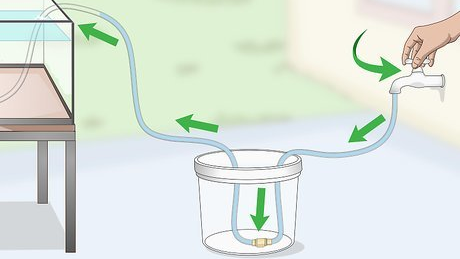If you’ve ever seen a magic trick where water appears to flow uphill, it’s likely that the magician used a hidden tube or pump to make it happen. You can create the same effect at home with a few simple materials. All you need is a clear container, a tube, and a pump.
Fill the container with water and place the tube inside. Connect the pump to the tube and turn it on. As the water is pumped through the tube, it will appear to flow uphill!
- Fill a container with water
- Place the container on a flat surface
- Place your hand over the top of the container, palm down
- Apply pressure to the top of the container with your hand
- Slowly lift your hand off of the container
- Observe the water flowing up the sides of the container
Credit: www.livescience.com
Is it possible to make water flow upwards?
Yes, it is possible to make water flow upwards. This is because water is a liquid and liquids are able to flow in any direction. It is also possible to make other liquids flow upwards, such as juice or milk.
The reason that water can flow upwards is because of the properties of water molecules. Water molecules are attracted to each other and this creates a force called surface tension. This surface tension is what allows water to flow in any direction, including upwards.

How can I make my water flow uphill without a pump?
If you want to make water flow uphill without using a pump, you can do so using a technique called capillary action. This is when water molecules are attracted to other molecules, such as those in a porous material. This attraction causes the water to rise up through the material.
One way to create capillary action is to use a wick. A wick is a thin, absorbent material that can draw water up through it. When the wick is placed in a container of water, the water molecules are drawn up the wick and into the air.
You can also use capillary action to make water flow uphill without a pump by using a sponge. To do this, you will need to wet the sponge and then squeeze it so that it is not dripping wet. Once the sponge is damp, place it in a container of water.
The water will be drawn up into the sponge and will start to flow uphill.
How do I make my water flow higher?
If you want to make your water flow higher, there are a few things you can do. One is to increase the water pressure. This can be done by installing a water pressure booster pump.
Another is to increase the diameter of your pipes. This will allow more water to flow through them and increase the pressure. Finally, you can install a water elevator.
This will lift the water up to a higher level, increasing the pressure and flow.
How can you make water flow upward against gravity?
There are a few ways to make water flow upward against gravity. One way is to use a pump. A pump creates a low pressure area on the bottom of the pump, which causes the water to be drawn up into the pump.
Another way to make water flow upward is to use a siphon. A siphon works by using the Bernoulli principle, which states that when a fluid (in this case water) flows through a constriction (such as a siphon), the fluid’s speed increases and the pressure decreases. This decrease in pressure causes the fluid to be drawn up into the siphon.
How to make water flow up without a pump?
If you’ve ever seen a water fountain, you know that water can flow upwards! But how does it work? It’s all thanks to something called hydrostatic pressure.
Hydrostatic pressure is the pressure that a fluid exerts on an object when the fluid is at rest. Water is a fluid, and when it’s at rest, it exerts a hydrostatic pressure on the objects around it. That pressure is caused by the weight of the water itself.
Now, how does that pressure make water flow upwards? It’s simple physics! The hydrostatic pressure of the water is greater at the bottom of the fountain than it is at the top.
That difference in pressure creates a force that pushes the water upwards. And that’s how water can flow upwards without a pump!

How to make water flow up a pipe
If you’re looking to make water flow uphill, you’ll need to harness the power of hydrostatic pressure. This is the force that allows water to flow from a higher to lower level. By using a pump to create this pressure, you can make water flow uphill!
Here’s how it works:
1. Attach one end of a hose to a water source, such as a faucet or garden hose.
2. Place the other end of the hose into a container that is higher than the water source.
3. Turn on the water and allow it to fill the hose.
4. Once the hose is full, turn off the water at the source.
5. The water in the hose will now be under hydrostatic pressure.
6. To make the water flow uphill, open the valve at the top of the hose.
How to make water flow up in minecraft
Water is one of the most important elements in Minecraft, but sometimes you need it to go where you want it to, not where gravity wants it to. Whether you’re trying to create a water elevator or just want to make a cool waterfall, making water flow up is a handy skill to know. Here’s how to make water flow up in Minecraft:
1. Find a water source. You can use a bucket to fill up a pool of water, or find a naturally occurring water source like a lake or river.
2. Place blocks around the water. Make sure the blocks are touching the water on all sides.
3. Place a sign on one of the blocks. The sign should say “water” on the first line and “up” on the second line.
4. Right-click the sign. The water should start flowing up!
Flow of water up a hill spontaneous or nonspontaneous
We all know that water flows downhill. But have you ever wondered why water doesn’t flow uphill? It’s all due to something called gravity.
Gravity is the force that pulls objects towards the center of the earth. This force is what makes it possible for us to walk and for water to flow. But what if we want to make water flow uphill?
Is that even possible? The answer is yes! You can make water flow uphill, but it takes a little bit of work.
First, you need to create a container that is taller on one end than the other. Then, you need to fill the container with water and wait for gravity to do its work. As the water flows downhill, it will create a pressure difference between the two ends of the container.
This pressure difference is what will cause the water to flow uphill. So, is water flow up a hill spontaneous or nonspontaneous? The answer is nonspontaneous.
Water Flowing Uphill: An Unusual Act of Gratitude
When water flows uphill, someone is repaying a kindness. The act of water flowing uphill is known as an act of kindness, and it is often seen as a way of thanking someone for their help. There are many stories and legends about water flowing uphill to repay a debt of gratitude, and this act is often seen as a sign of respect.
In some cultures, the act of water flowing uphill is seen as a way of bringing good luck.
River that flows uphill at Ireland
The river that flows uphill in Ireland is called the River Suck. It is located in the province of Connacht and is a tributary of the River Shannon. The River Suck is approximately 18 miles long and is one of the most popular tourist attractions in Ireland.

Why does water flow downhill?
Water flows downhill because of gravity. Gravity is the force by which a planet or other body draws objects toward its center. The force of gravity keeps all of the planets in orbit around the sun.
Earth’s gravity is what keeps you on the ground and what makes things fall. Water always flows from higher to lower ground because gravity pulls it down. When water is at a higher elevation, gravity pulls it down the slope.
The steeper the slope, the faster the water flows. Water can flow uphill if it is moving fast enough. If water is moving quickly enough, it can overcome gravity and flow uphill for a short distance.
However, this is not a sustainable situation and the water will eventually fall back down the hill. In summary, water flows downhill because gravity pulls it from high ground to low ground. It can flow uphill if it is moving quickly enough, but it will eventually fall back down.
Flow of water
The term “flow of water” is used to describe the movement of water from one place to another. This can happen in a variety of ways, such as through rivers, lakes, and oceans. The flow of water is an important aspect of the water cycle, which is the process by which water moves from the Earth’s surface to the atmosphere and back again.
The flow of water is driven by a variety of forces, including gravity, wind, and tides. Gravity is the force that pulls water down from the atmosphere and towards the center of the Earth. This is what drives the flow of rivers and lakes.
Wind can also cause the flow of water, especially in the case of tides. Tides are caused by the gravitational pull of the moon and sun on the Earth’s water. As the water is pulled towards the moon or sun, it creates a bulge in the water.
This bulge is what causes the tide to come in and go out.
Conclusion
This is a common question with a simple answer. To make water flow uphill, you need a pump. The most common type of pump is a centrifugal pump.
It uses a spinning impeller to draw water into the center of the pump, and then flings it outwards with centrifugal force.






2 Responses